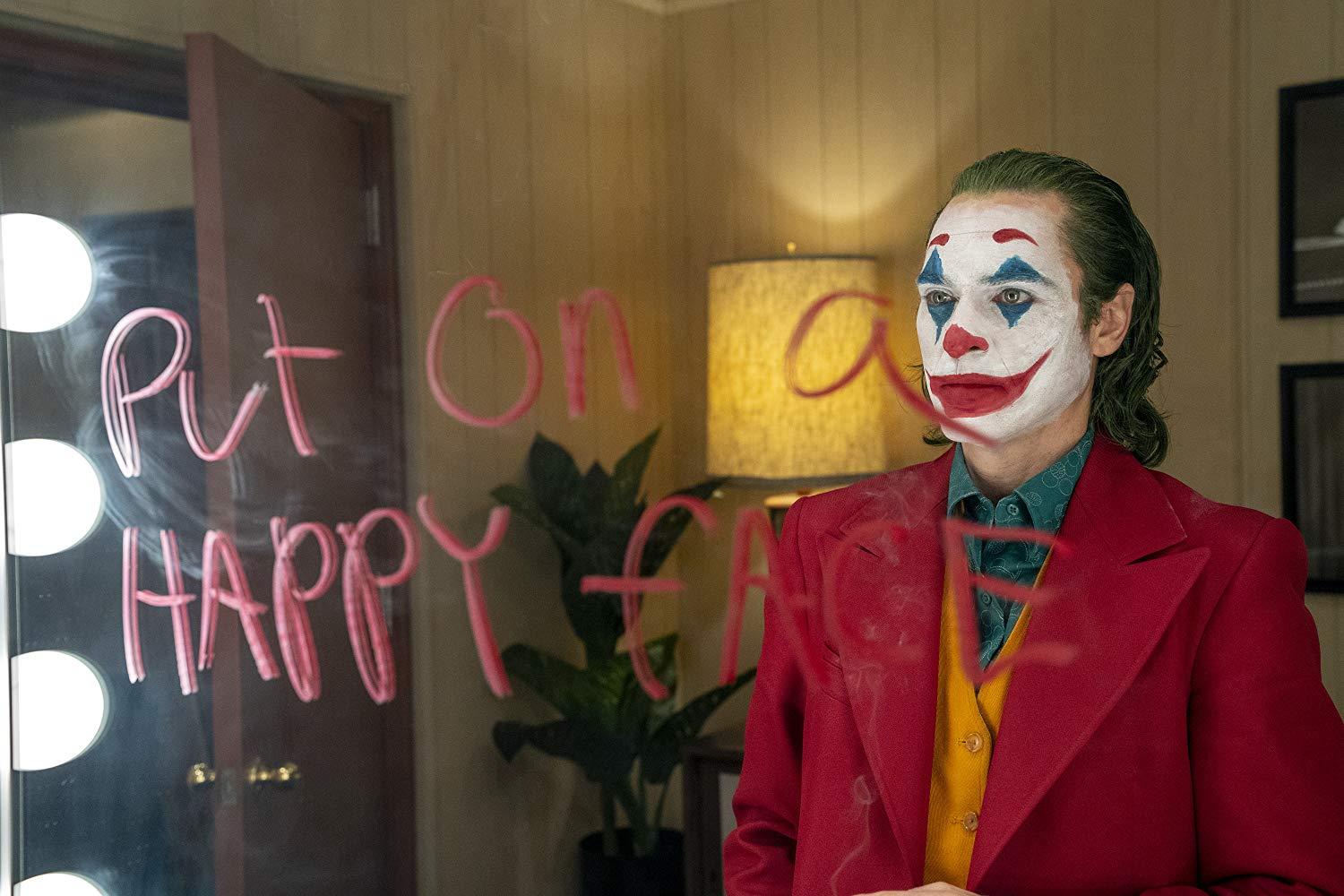“The horror!” Marlon Brando exclaims near the end of Apocalypse Now, having seen the uncut evil shredding humans into hollow men. He might have shouted something similar at Heath Ledger’s Joker from The Dark Knight, a character whose scraped-out soul feeds on a regenerate well of madness. Ledger creates a character who overcomes our own dual-looking, the backward and forward gaze that gets us into so much trouble, perverting our desire for fruitful presence into inscrutable mania. The Joker is succinct, caged by the fluid chaos of successive moments and diminished in purity by any historical elaboration. Inexplicability defines the Joker’s actions in the filmic space, creating a slippery, “what’s next” pop as opposed to the omniscient sigh imposed by, a legible, historical motive.
In Joker, Todd Philips wannabe origin-epic, Arthur Fleck (Joaquin Phoenix) is the humane predecessor to Ledger’s destruction conductor, a benign but unstable loner living with his mother, Penny (Frances Conroy), working as a street clown and aspiring stand-up comedian. He lives in Gotham, a city convulsing with what feels like hopeless economic ills, in a political climate on the brink of capitulating to a dubious messiah in the form of Thomas Wayne (Brett Cullen), a billionaire promising to lift the impoverished from their squalid scene. Defunded social programs, penny-pinching bosses and selfish co-clowners don’t help Arthur much, nor does his unfortunate (and eventually wearisome) tic that causes him to laugh uncontrollably at random, unfunny intervals. This high-pitched “condition” gets him routinely beaten senseless in moments of misunderstanding, and the opening sequence of Joker, where Arthur ingenuously chases and is brutalized by a group of mean-spirited teens, is brutal, hopeless and disturbing. It introduces the film’s thesis statement, focused on the moral shortcomings of an insensate society, one that will grind Arthur past tragedy into indifference. If only the rest of the film turned Arthur’s oddball sweetness over a pit of cynicism, but instead, the violent crescendos make the overall feeling elicited by Joker mild and mostly empty. The endgame’s extreme necessities do not allow for slight maneuvers or intimate lashings, although the film, for a split-second, holds the isolated note of a Charlie Kaufman script. But Kaufman’s meditative isolation has no part to play in Phillips grander vision.
Yet there are a few flashes of virtuosic film-making, meted out in shivers and squirms. Though the film is informed by a largely Scorsesean ethos, (Taxi Driver and The King of Comedy both live inside Arthur’s gauche behavior and obliterating humiliations, occurrences that eventually bring him to a violent boil, and New York informs Gotham’s own urban fallout), Joker still makes a few compelling choices.
Phillips washes Arthur in a kind of apocalyptic low-light — as if the sun is setting on his lucidity — while occasionally lacerating him with spears of nether-worldly brightness. The sopping, bone-deep gray of Gotham at large, coupled with these mars-dust suffusions, creates a maddening dichotomy between a loosening psychic state and an anomic world. It’s a double-trouble texturing that cages Arthur’s unraveling within subjective and objective spheres, a kind of intense reverberation foreshadowing the extremity to come.
There are also several notable sequences in Joker. The first is a trance-dance sequence, bridging the first two acts, in a grimy subway bathroom. It is scored brilliantly by Hildur Guonadóttir with waves of elegiac, transformative dread, her notes forming in the ear like pieces of a developing nightmare. Long, kneaded strings elaborate the process of monstrous recognition, as Arthur shimmies out of a petrified person into an amorphous idea. If the whole film could have achieved what the portions of Guonadóttir’s score does, it would be have a canonical slow-horror film.
There’s also a flashback scene with Arthur’s mother, Penny, as she’s read a personal truth in a psychiatric hospital. Arthur looks on in spirit, in the mode of cinematic revelation, but the import of Phoenix the actor is what brands us. It is a small moment, miniscule even, but enough to make one shudder and smile. Phoenix’s entire performance gleams in this instance as he channels Ledger’s growling command to “Look at me!” Insouciantly acknowledging the narrative, himself and an entire film-history, we are told: “This isn’t Heath, it’s me.” It’s remarkably simple: his head tilted down, greasy hair in his face, eyes boring a despondent hole in the universe.
Music in Joker is incessant, and if Guonadóttir’s score delivers some special moments, others are over-wrought with meaning. Never does a sickening sequence pass without strong aural signposts. The undercurrent orchestra mostly pounds our skulls with Joker’s impending madness, while occasionally fading for jazz numbers and Sinatra songs, old hits that come across as irresponsibly re-purposed shortcuts to mood, like the trend in trailers or car commercials that slows down, bastardizes or otherwise mangles a canonical number like “Over the Rainbow.” Sinatra booms through Joker as a twisted masculine mantra, skewing sonority into monolithic perversity, a snappy, show-biz insanity faking psychological musculature. The platitudinous lyrics of Sinatra, Tony Bennett and Nat King Cole represent a constellation of bought-into bromides hiding some deeper discomfort, but the result in most films has always been banal and vague. If the dreamy dread of the orchestra overwhelms at times, these songs are meant to take that dread and aerate it through pop, but most of what we receive is a disjunctive, over-emphasized aural experience.
Joker operates under the notion that the most profound evil comes from a genuineness continually deflected. It’s a lesson in ‘don’t ignore the outcast,’ and the heavy-handed monologue near the end of the film makes the lesson seem rather elementary. If one does not conform to the strict moral and social codes of a society, they are consequently sequestered in jaded misery. The anomic milieu as the source of annihilation and violence is old news, but the anticipation heading into Joker come from seeing Ledger’s endpoint. How will Phillips get us there? It’s not possible, is the answer. Phillips’ film, although compelling in its conceit, fails precisely because its subject resists history. A quantification of sinister history is impossible, and can only ever glance Ledger’s perfectly present ideal. No matter how deranged Phoenix becomes, the Joker will always resist this human quality of becoming. The ultimate failure of Joker comes from the impossibility of fruition, and one gets the impression that if Ledger’s Joker met Phoenix’s, he would eat him alive, if only because Phoenix’s version once sat through therapy.







